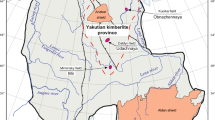Abstract.
Mafic granulite xenoliths from the lower crust of the Pannonian Basin are dominated by LREE-depleted bulk-rock compositions. Many of these have MORB-like 143Nd/144Nd but 87Sr/86Sr is elevated relative to most MORBs. Their δ18O values cover a wide range from +3.8 to +9.5‰. A group of LREE-enriched mafic granulites have higher 87Sr/86Sr (0.704–0.708) and lower 143Nd/144Nd (0.5128–0.5124), with higher δ18O values on average (+7.8 to +10.6‰) than the LREE-depleted granulites. The LREE-enriched granulites are, however, isotopically similar to newly discovered metasedimentary granulite xenoliths. A sublinear correlation in εHf–εNd isotope space has a shallower slope than the crust–mantle array, with the metasedimentary rocks forming the low εHf end member; the radiogenic end is restricted to the LREE-depleted granulites and these overlap the field of MORB. Pb isotopes for the LREE-depleted samples are less radiogenic on average than those of the LREE-enriched and metasedimentary xenoliths, and metasedimentary granulites have consistently higher 208Pb/204Pb. The wide range in δ18O over a restricted range in Nd and Sr isotope values, in combination with the predominance of LREE-depleted trace-element compositions, is consistent with an origin as a package of hydrothermally altered oceanic crust. The existence of δ18O values lower than average MORB and/or mantle peridotite requires that at least some of these rocks were hydrothermally altered at high temperature, presumably in the oceanic lower crust. The low 143Nd/144Nd of the LREE-enriched mafic granulites cannot be explained by simple mixing between a LREE-depleted melt and an enriched component, represented by the recovered metasediments. Instead, we interpret these rocks as the metamorphic equivalent of the shallowest levels of the ocean crust where pillow basalts are intimately intercalated with oceanic sediments. A possible model is accretion of oceanic crustal slices during subduction and convergence, followed by high-grade metamorphism during the Alpine orogeny.
Similar content being viewed by others
Author information
Authors and Affiliations
Additional information
Electronic Publication
Rights and permissions
About this article
Cite this article
Dobosi, G., Kempton, P.D., Downes, H. et al. Lower crustal granulite xenoliths from the Pannonian Basin, Hungary, Part 2: Sr–Nd–Pb–Hf and O isotope evidence for formation of continental lower crust by tectonic emplacement of oceanic crust. Contrib Mineral Petrol 144, 671–683 (2003). https://doi.org/10.1007/s00410-002-0422-1
Received:
Accepted:
Issue Date:
DOI: https://doi.org/10.1007/s00410-002-0422-1




